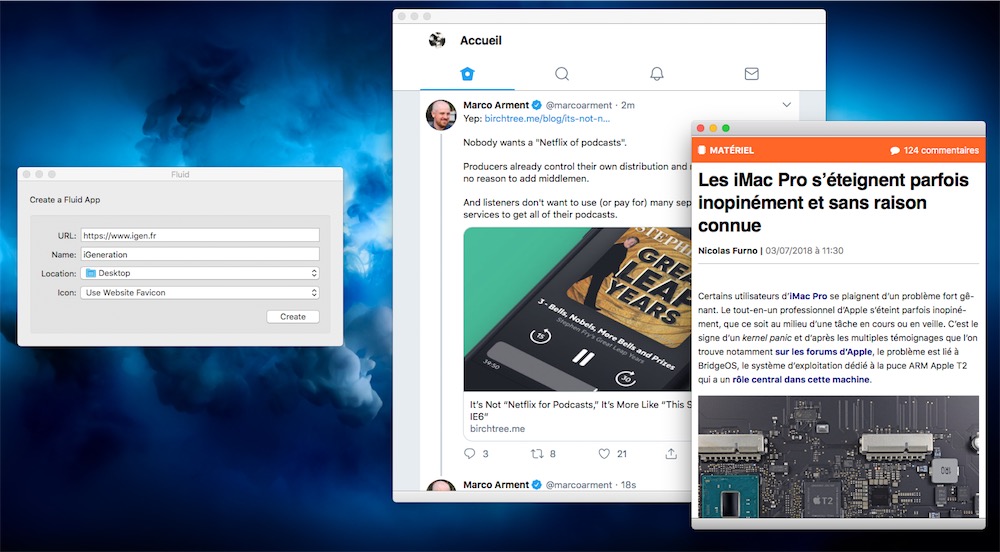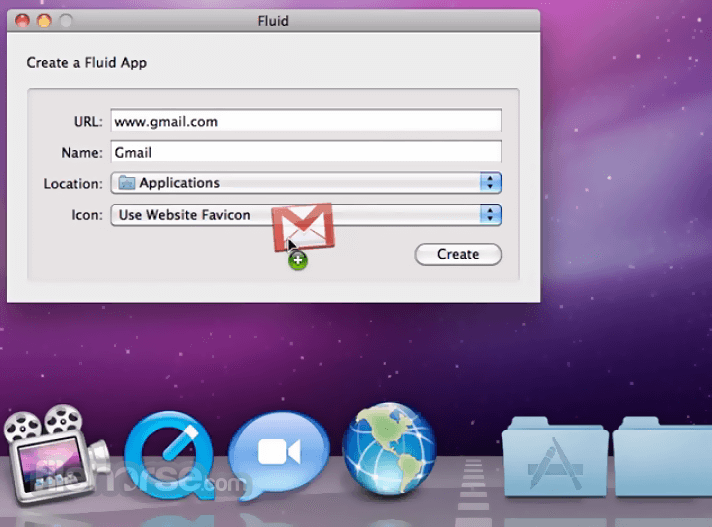Station is the first smart workstation for busy people. A single place for all of your web. Mailplane is the Mac desktop app that we use everyday to manage our Gmail inbox. We like it because it mimics all the features that you get on Gmail in the browser while providing a desktop app to manage your gmail separately from the (always cluttered) browser experience. You get access to all your Gmail settings such as labels, keyboard. Fluid is a small Mac utility that can help you transform any website into a desktop client without having to deal with complex tools or make too many adjustments. User friendly design To create a desktop client, simply run the Fluid app: in the main window you must input the website URL, set up a name, an. Download Java 10.6 For Mac Fluid App Keygen Mac 2016 Talking Tom Cat Game For 5233 Free Download Song Yellow Polka-dot Bikini Zip Code Kuwait Fahaheel Photos Free Aimsun Scripting Manual Programs Fifa Street 4 Psp Iso 2018 Hot Virtual Keyboard V5.3.1.0 Download Opera Mini Handler S60v3 Sis Wreck It Ralph 2 Piratebay. Fluid Mask for Mac Download Masking can describe either the techniques and materials used to control the development of a work of art by protecting a desired area from change. What is Fluid Mask app? Fluid Mask is a tool to cut out masks in photos. Download Fluid Mask and carry out precise selections of any elements in an image.
If you're a regular Cloud Coach reader, then you know that I'm very interested in philosophies, techniques, and specific applications that help us be more productive with the technology in our lives.

While our focus here has typically been on web-based things, last week we entered the desktop space and talked about how to clean up your computer when files get disorganized and out of hand.
This week, I want to talk about the intersection between the web and our desktops.
I know this may seem irrelevant as we move more towards computing solely in the cloud. I would argue that having a computer desktop that is well suited to the way that you work is paramount to staying productive and motivated. Sure, Google Drive lets me store all my files in the cloud, but is it useable in a meaningful way?
Moving to the Cloud is all about giving up control over some things (User interface, speed, quality, etc.) in exchange for others (convenience, ubiquity, mobility).
Fluid The App
My rambling aside, any time we can have both of those things (control and convenience), the user wins. I've found a rather elegant solution to a problem that I'm sure you have. With the rise of all these web applications that are meant to replace our desktops, it can be really hard to use them when they get lost in a sea of other browser windows and tabs.
The solution? Turn a website into a desktop application
How to turn a website into a desktop application
It's really quite simple- All you'll need is one of these free programs:
- Fluid for Mac
- Google Chrome for Windows
Note that Fluid is a standalone application that creates these things (called Site Specific Browsers), and Google Chrome is a (really great)browser. Interestingly enough, Google Chrome for Mac doesn't do this.
Fluid for Mac
Fluid Browser
Fluid's webpage says it best:
These are apps complete with their own settings, behaviors, and customizeable icons.My favorite thing about fluid is that while it can do a lot, you don't have to get in depth to turn your favorite website into a desktop application.
Watch as I turn the scheduling application Doodle into a desktop app:
Easy, right?
The mark of a good desktop application is how it behaves.
Now that I've created a desktop version of Doodle, I don't want it to behave like a browser tab. Here's why- when I close an application window on my mac, it doesn't quit the application. It's still running, so when I click the icon in the dock the last window I was on springs open. This usually isn't the case on the web. When you close a browser tab, it's closed. You can go back to the website but it has to re-load.
Fluid addresses this by allowing you to choose what happens when you click the close button:
Google Chrome for Windows
The process for creating desktop-app versions of websites in Google Chrome for Windows is even simpler. Unfortunately, you don't get some of the slick options that you would in Fluid, but the end result is just as useful.
Step 1: Open the website you want to convert to an app in Chrome
Fluid App For Mac
Step 2: Click the Wrench Icon
Flotato Mac
Step 3: Navigate to Tools > Create Application Shortcuts…
Step 3: Choose where you want the icons to appear. Your choices are Desktop, Start Menu, and Pin to Taskbar. I generally prefer to keep icons on my Windows Desktop, and leave the taskbar only for applications that are running. If you want your Windows 7 machine to look more like the mac dock, you can pin applications to your task bar.
Now, when you launch the website from your shortcut, it will be in a chrome window with no navigation controls, buttons, shortcuts, or other distractions. Unlike Fluid, when you click X, the window will close though- be careful!
What should you create apps for?
I've created apps for Google Voice, Doodle, and Workflowy. I used to have one for my favorite scheduling app, Tungle.me, but just found out that it was going offline in a month 🙁
I would certainly create one for Gmail, except that I use a wonderful software called Mailplane that is just for Gmail. It does what Fluid does but also makes Gmail behave more like a desktop mail application.
Creating 'Native' Java Applications on Mac OS X. If you develop on Mac OS X you can use the Jar Bundler application to turn jar files into Mac OS X applications. Jar Bundler is distributed with the other developer tools and is located in Developer/Applications/. Java for OS X has been created to mix OS X's advanced technologies and Java's adaptability and omnipresence on almost all software platforms out there. The newer Java packages are maintained by Oracle, therefore it is recommended to use Oracle's Java JRE. If you have not yet installed Apple's Java OS X 2012-006 update, then you are still using a version of Apple Java 6 that includes the plug-in and the Java Preferences app. See 'Note for Users of OS X that Include Apple Java 6 Plug-in'. There can be multiple JDKs installed on a system, as many as you wish. Mac OS X 10.6 and below: Apple's Java comes pre-installed with your Mac OS. Mac OS X 10.7 (Lion) and above: Java is not pre-installed with Mac OS X versions 10.7 and above. To get the latest Java from Oracle, you will need Mac OS X 10.7.3 and above. If you have Java 7 or later versions, you will see a Java icon under System Preferences. 
Now that you can create desktop apps out of your favorite websites, what will you use it for?
Note: If you buy something linked to in one of our posts, we may get a small share of the sale.
If you’re like me, you might have thought, “I really wish I didn’t have to open a browser or switch browser windows every time I want to check Asana.” I hoped Asana, Inc. would make a native Mac app so I didn’t have to deal with this, but it wasn’t on their radar.
Fortunately, I discovered an incredible free piece of software called Fluid. Fluid basically turns web apps into native Mac apps that you can put right in your dock. This was important for me because as Asana became a major part of my workflow, I wanted it to behave like Things, which has been one of my favorite productivity apps for non-work tasks.
The process is simple. Download and install Fluid and when it asks for the URL of the web app, just copy and paste the link of your “My Tasks” Asana page. Fluid does the rest to create an app that you can place in your dock for all your productivity pleasure. It also works great for other web apps, like Google Analytics or Spotify.
Pro Tip: I like my dock and desktop to look nice, so I changed the icon of the resulting Asana app so that it looks like an Asana icon. Here’s how to do it:
- Download a 512×512 pixel or larger Asana (or generic productivity) .png like this one: Download
- Right-click the .png you downloaded and select “Get Info.” Click on the icon in the top left of the info window so it gets a blue highlight. Press “CMD + C” to copy. (Note: If you only see a generic .png logo instead of the icon you want to copy, open the .png in Preview, press “CMD + A” to highlight everything and then press “CMD + C” to copy)
- Right-click the Asana app and select “Get Info.” Click the icon so there’s a blue highlight, and press “CMD + V” to paste.

There you have it! A beautiful logo on your app that you can stick in your dock.
One final note: If you integrate Asana with other platforms (like Google Drive, Dropbox, Box, Harvest, etc.), you may need to go into the preferences and whitelist a few URLs so Fluid knows it’s OK to visit those sites as well. So as an example, if your organization tracks time using Harvest (save 50% off your first month using coupon code ASANATRAINING) then do the following:
- Click on your newly created Asana “app” and then click on the name of the app in the toolbar.
- Go to “Preferences” and then “Whitelist.”
- Add the following URLs for the services you plan to use (including asterisks):
- *google.com* (Log in through Google)
- *harvestapp.com* and *getharvest.com* (Harvest time-tracking)
- *box.com* (Box file-sharing)
- *dropbox.com* (Dropbox file-sharing)
Fluid Downloader
Download Fluid (Free)

